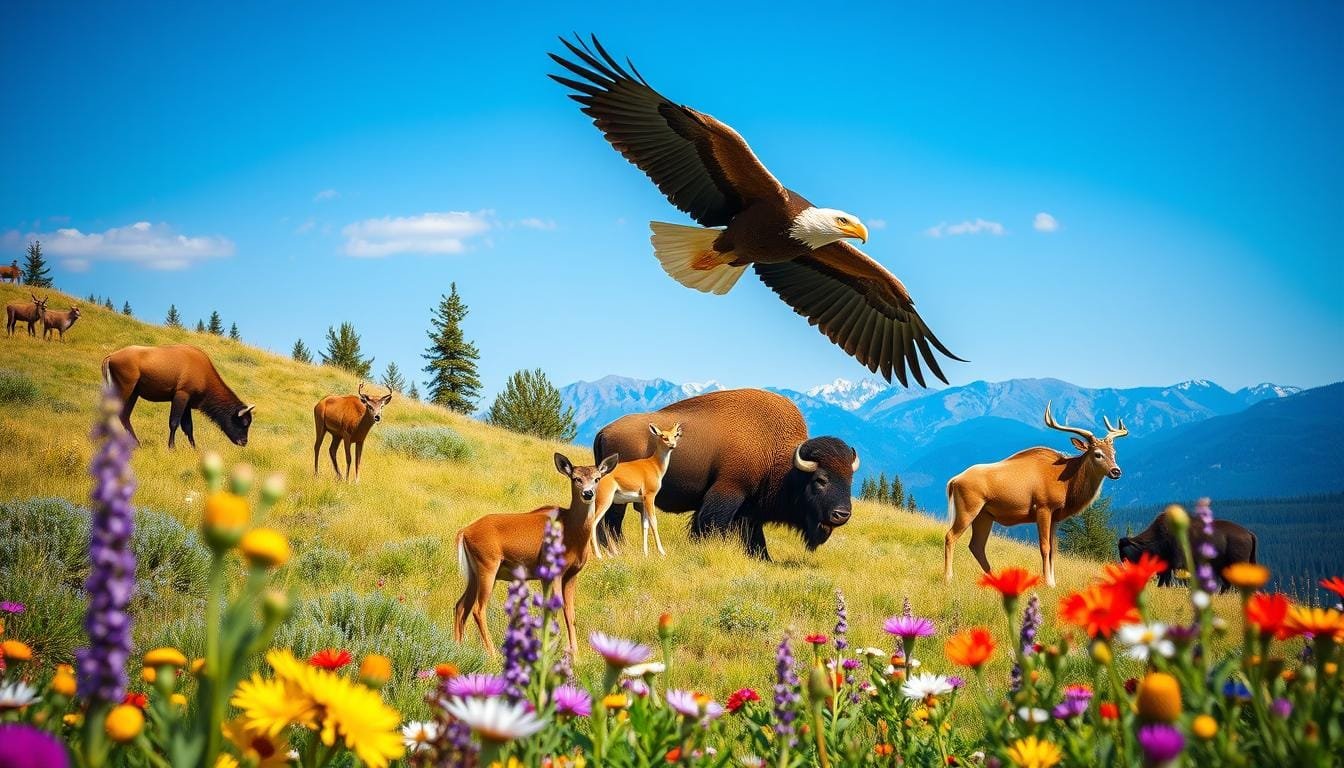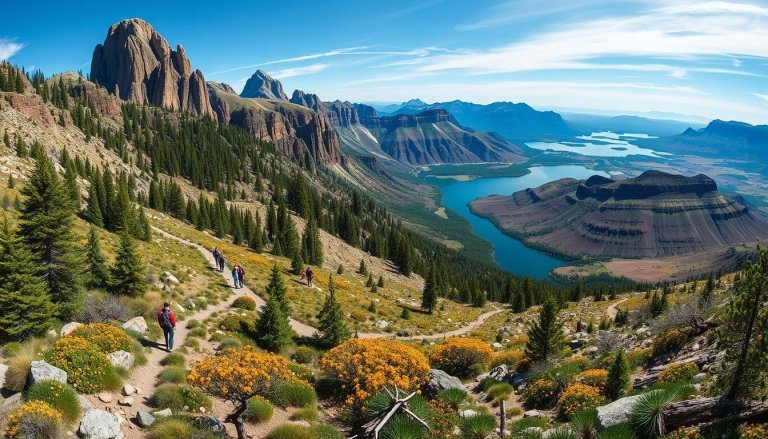The USA’s national parks are full of wildlife. They give visitors a chance to see nature’s wonders up close. You can see everything from Yellowstone’s animals to Yosemite’s wildlife in their natural homes.
National park wildlife varies a lot across the country. In Yellowstone, you might see grizzly bears, wolves, or bison. Yosemite has black bears, mule deer, and over 250 bird species. The Olympic National Park is home to 62 land mammals and 29 marine mammals. Lake Clark National Park has caribou, Dall’s sheep, and both black and brown bears.
Seeing wildlife in USA national parks is exciting but not guaranteed. Parks like Yellowstone, with its 2.2 million acres, are great for spotting animals. Remember, these creatures are wild. Watching them in their natural home is a special experience that needs patience and respect.
Whether you want to see bald eagles or elk, the national parks of the USA are perfect. They offer great chances to connect with nature and see the diversity of our country’s animals. Just remember to stay safe and follow park rules to protect both you and the animals you admire.
USA National Park Animals: An Overview of Wildlife Diversity

America’s national parks are full of amazing wildlife. From the Grand Canyon to Glacier National Park, they are home to many species. Let’s explore the variety of animals in these natural wonders.
Native vs Non-native Species in Parks
National parks have both native and non-native animals. Native species have lived there for a long time. Non-natives came from humans. The NPSpecies database helps manage these differences.
Common vs Rare Animal Sightings
Some animals are easy to find, while others are rare. In Glacier National Park, you might see mountain goats and elk. Everglades National Park is home to rare marsh rabbits.
| Park | Common Sightings | Rare Sightings |
|---|---|---|
| Grand Canyon | Mule Deer, Rock Squirrels | Mountain Lions, Ringtails |
| Glacier National Park | Mountain Goats, Elk | Grizzly Bears, Wolverines |
| Everglades National Park | Alligators, Herons | Florida Panthers, Manatees |
Seasonal Wildlife Viewing Opportunities
Animal activity changes with the seasons. Spring brings new life and birds. Summer is active for predators. Fall is for mating, and winter shows how animals adapt to cold.
Wildlife watching needs patience and respect. Always follow park rules for your safety and the animals’. Enjoy watching wildlife in America’s beautiful national parks!
Most Popular National Parks for Wildlife Watching
The USA has many national parks full of wildlife. Yellowstone National Park is home to nearly 60 mammal species. It’s one of North America’s richest wildlife areas. Its neighbor, Grand Teton National Park, also has a lot of wildlife, thanks to the Greater Yellowstone Ecosystem.
Rocky Mountain National Park in Colorado has 67 mammal species. You can see pikas, yellow-bellied marmots, bighorn sheep, and elk there. Glacier National Park in Montana has over 70 mammal species, including grizzly bears, mountain goats, and wolverines.
Katmai National Park in Alaska is great for bear watching. It has only 5 miles of trails but is perfect for seeing brown bears. You can also see gray wolves, sea lions, and humpback whales there.
Redwood National Park has many animals that live in its forests. Acadia National Park in the Northeast has a lot of wildlife too. Denali National Park in Alaska is home to hardy creatures that live in the cold.
| National Park | Notable Wildlife | Mammal Species Count |
|---|---|---|
| Yellowstone | Bison, wolves, grizzly bears | Nearly 60 |
| Rocky Mountain | Elk, bighorn sheep, marmots | 67 |
| Glacier | Grizzly bears, lynx, mountain goats | Over 70 |
| Katmai | Brown bears, wolves, sea lions | More than 40 |
Safe Wildlife Viewing Guidelines and Best Practices
Exploring USA national park animals is thrilling, but safety comes first. Let’s dive into the dos and don’ts of wildlife watching. This ensures a fantastic experience for both you and the animals.
Recommended Viewing Distances
When observing national park wildlife, keep your distance. Park rules say stay at least 25 yards from most animals. For predators like bears and wolves, it’s 100 yards. At Olympic National Park, the minimum is 50 yards. These rules protect both you and the animals.
Essential Wildlife Photography Equipment
Capture stunning shots of Yellowstone animals without getting too close. Pack these must-haves:
- Binoculars for distant viewing
- Telephoto lens for close-up shots
- Tripod for steady shots
- Wide-angle lens for landscape photos
Park Ranger Safety Tips
Park rangers are your best resource for safe wildlife viewing. They recommend:
- Never feed animals – it’s dangerous for them and you
- Store food properly to avoid attracting wildlife
- Report any unusual animal behavior or sightings of sick animals
- Stay on designated trails to minimize impact on wildlife habitats
Best Times for Animal Observation
Early morning and late afternoon are prime times for spotting USA national park animals. Many creatures are most active during these cooler hours. Dawn offers the bonus of beautiful sunrise views, while dusk provides a magical atmosphere for wildlife watching.
Conclusion
USA national park animals show off amazing wildlife diversity. Places like Yellowstone have iconic bison herds. Yosemite is home to rare mountain lions. These parks are safe homes for many species.
Seeing wildlife in these parks is a thrill. But, it’s important to watch from a distance. Keep at least 50 yards away from most animals and 300 feet from bears. This keeps everyone safe.
Visiting national parks is best all year round. Spring in Acadia means seeing birds migrate. Fall in Rocky Mountain National Park is great for elk watching. Always be patient and respectful to enjoy nature fully.



